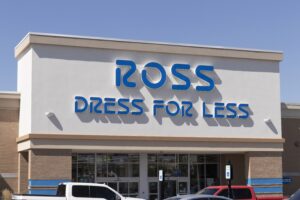Source: iStock | Nancy C. Ross
May 22, 2023
Does Retail Need a New Approach to Fight Organized Crime?
Inventory shrink driven by organized retail crime is expected to reduce Target’s profitability by an additional $500 million this year, the retailer’s CEO Brian Cornell said last week.
“The problem affects all of us, limiting product availability, creating a less convenient shopping experience, and putting our team and guests in harm’s way,” Mr. Cornell said during the discounter’s first-quarter analyst call. “The unfortunate fact is violent incidents are increasing at our stores and across the entire retail industry.”
Target’s mitigation efforts include investing in security personnel, locking up or adjusting assortments in affected stores, and collaborating with legislators, police and retail partners.
Mr. Cornell said Target remains committed to keeping its affected stores open. “Our stores create jobs, serve local shoppers, and act as critical hubs in communities,” he said.
According to the National Retail Federation’s 2022 National Retail Security Survey, organized retail crime incidents rose 26.5 percent in 2021.
Home Depot, Lowe’s, Best Buy, Walgreens and CVS in recent years have also expressed public concern over organized bands of thieves ransacking their stores and reselling goods on online marketplaces.
Walmart CEO Doug McMillon warned last December that rising theft could lead to store closures and price hikes.
New York City Mayor Eric Adams last week announced a comprehensive plan to combat retail theft across the city informed by a summit held in December composed of retailers, law enforcement officials, union leaders, business improvement districts and others.
Steps include installing in-store kiosks to connect individuals in need with government resources and social services, establishing social service programs for non-violent offenders, improving tracking for repeat offenders and organized crime rings to facilitate stronger prosecutions and creating enhanced online authentication procedures to prevent the resale of stolen goods.
Training on de-escalation and anti-theft techniques is being provided to store associates.
Neighborhood retail watch groups are being set up for businesses to share information on theft incidents with each other and law enforcement.
“Most importantly, this plan aims to reassure our store owners that we know they are essential to our city, and we have their backs,” Mr. Adams said.
Discussion Questions
DISCUSSION QUESTIONS: Which procedures and/or practices offer the most hope for combating organized retail crime? Do you have any outside-the-box ideas for reducing incidents?
Poll
BrainTrust
Lisa Goller
B2B Content Strategist
Jeff Sward
Founding Partner, Merchandising Metrics
Gene Detroyer
Professor, International Business, Guizhou University of Finance & Economics and University of Sanya, China.
Recent Discussions







How about good old-fashioned consequences? How about jail? How about differentiating between stealing a candy bar and grabbing a whole fixture of apparel and smashing a case of jewelry? Yes, better social services have a role, but when lines are crossed so do appropriate consequences.
Organized retail crime is an issue, but I think comments made during Target’s 1Q23 earnings call have been misconstrued. Target’s CFO stated that shrink is on pace to reduce profitability by $500M compared to last year, but the $500M figure was not specific to ORC. (The NRF’s industry stats attribute most shrink to causes other than ORC.)
Many of the initiatives described above seem sensible, but Target may need to explore other drivers of shrink in parallel.
Yes, new approaches are needed but retailers can’t take a bite out of organized retail crime without national and local support. Store associates cannot take on the role of police and local police don’t always have the bandwidth to deal with the crime that comes to town in the wake of retailers breaking ground. I’m forecasting that for the rest of this year and going into 2024, retailers will invest heavily in mitigating ORC. As exciting as the upside for new technologies is, applying them to this profit-killer is job one.
I’ll jump again on my RFID soapbox as it is a solution to many LP issues. Serialized inventory that marks a product as unique is one tool in the arsenal. Another is full-product scanning at POS that doesn’t miss a scan, and entry and exit gates that check to see if product’s are paid for. All this is a reality in an RFID world but, few of us have embraced the technology. The ROI is there. You just have to do the math.
As for the bigger law question, we can’t let retail shops become fair game for criminal games. The laws must be stepped up and enforced universally, even if it’s more difficult to enforce them in urban areas. Otherwise we’ll see more inner city store closings.
I ran a boutique that was targeted several times by groups of organized shoplifters, let me tell you it was terrifying.
These weren’t people who would have benefited from in-store kiosks that connect them with government resources, and I don’t think the groups shoplifting today will be either. Retailers need real protection, especially those on the front line.
Organized retail crime is a huge problem, but the lack of consequences for blatant theft results in theft by individuals. At least 15% of my Target’s merchandise is locked up. Jeff Sward is right — let’s see some consequences.
I’m with my colleague, Jeff Sward, on this issue. The consequences of ORC need to be amped up with much more severe penalties that our judicial system enforces to the fullest extent. If we don’t do this, criminal rings will become more brazen, more stores will close, more jobs will evaporate and this vicious cycle becomes extremely problematic for our country.
Expect more tech (surveillance, smart carts, alarmed devices) in stores to mitigate shoplifting. Locked cases and security guards have also become more prevalent in 2023.
Retailers must collaborate with law enforcement, industry task forces, governments and communities to reduce incidents of theft.
Okay, I’m going to be Doubting Debbie here for a moment. In 2021, Target’s revenue was 93 Billion. That puts this $500 million at .54% of sales at retail. Shrink generally has run about 1.6% of sales, depending on the category.
I know the NRF has been harping on ORC as an issue for years, and some of the events that have occurred have made for great press coverage BUT….can someone show me that at least 50% of shrink is no longer driven by employee theft of goods and cash? And 30% by administrative errors. In our last survey (which was too long ago), only 29% cited ORC as a top-three source of shrink. 71% said it was employee theft of merchandise in stores.
It feels like the excuse du jour to me….especially since the industry has been talking about Just Walk Out checkout (and locking cabinets, but that’s a solution that’s been around a long time.
I just want to see data. I know the University of Florida no longer runs its annual survey. It showed similar numbers to our data, and like ours, the numbers moved glacially.
I’m not all in on this one at all.
Perhaps I am a naysayer.
It could be better enforcement. Only about 2% of shoplifters get caught. But what would police in every aisle look like, and what cost?
How about facial recognition? When a known shoplifter enters the store, all the bells and whistles are released.
This is a cultural problem. I don’t see it changing, as over half of all shoplifters are under 18. Young shoplifters are as likely to be found in urban, suburban, and rural areas.
My China experience influences me. Shoplifting is not comprehended. If someone shoplifts, they are likely to be stopped by other customers. It is considered a crime against society, not against the retailer who can surely “afford it.”
The problem can’t reasonably be solved at the physical store level. Locking up everything from socks to shampoo behind locked glass cases deters buyers as much as thieves and does nothing to stop the violence. Staff aren’t trained to deal with crime at this level – nor should they be. Only deep collaboration among both communities and retailers will resolve this. Get marketplace platforms to require proof of ownership for their sellers will help block pathways to sell stolen goods, and penalties for not checking (like pawn shops today). Establish police outposts with relevant training to enable faster response times to in-store theft. Increase monitoring and product tracking to assist in catching thieves post-incident. And of course the underlying case of this increase in theft is growing poverty and shrinking accessibility to education and meaningful employment, which can’t be solved but can certainly be better managed. This is not a problem that can be solved quickly by more technology.
ORC has been growing exponentially over the past decade. The best practice for reducing ORC is working in a collaborative manner across retailers. Spotting trends early and learning the new ways in which ORC operates help asset protection groups to stay ahead. The asset protection community is strong and working together will help reduce the barrier for all retailers. Using cameras with watermarked video footage can help when cases go to court and today’s technology has this feature. But retailers need the courage and culture to prosecute.
Hi Shelley! I am really hungry to see data on those numbers. I have seen none.
When it comes to organized retail crime the emphasis needs to be placed on “organized.” Teenagers, low income individuals, etc., etc. need to be addressed differently than their more organized peers. As in the case of drug enforcement, it doesn’t do you much good to focus on busting users unless they lead you to the source of supply.
“Sweepers” have to sell their goods to someone, and that someone likely sells those goods along to someone else. Find the head, cut it off, and the snake dies. Organized theft will go away the minute the market for stolen goods does, and that’s not going to be any day soon at the rate we’re going.
I know this sounds odd, but Retail needs to hold local governments accountable to do their job. The current situation can’t be solved by Retailers alone. Here in Portland there is both organized crime, but also plenty of shop lifting that takes place by individuals who are basically going “shopping for free”. There are no consequences, from civic officials, and the (correct) Retailer policy of insuring their own employees don’t interfere for safety reasons means people can just walk in and walk out without paying as they wish and with no worries of consequences. Even if local authorities just did spot patrols of Retail locations and arrested shoplifters creating the possibility that if you shop lift you will be arrested, it would cut down on theft. Going after organized crime is something that local authorities have an obligation to do. Back in the day stores had internal Loss Prevention teams that patrolled stores, AND apprehended shoplifters and turned them over to the police. I guess those days are gone.
I think it’s fair to say that the primary motivation for flash-mob ransacking in retail stores is “resale” on e-commerce sites.
Our first step should be enacting laws to help make it harder for random “sellers” to resell. eBay, for example, and similar sites must cooperate. Those companies are very aware of how their current business models facilitate the resale of stolen goods.
When it comes to flash-mob violence, Target’s mostly pragmatic approach makes more sense than the New York mayor’s social approach.
Increasing armed security personnel may sound unfriendly and expensive, but it must be part of the solution.
Collaboration with local police is also essential, but keep in mind that many cities have defunded, or cut back, in police personnel.
All aspects of storing products under lock and key are terrible. By doing so, it destroys the brick and mortar shopping experience and encourages consumers to shop online instead.
Moreover, the lock up system requires more personnel at the point of sale to unlock merchandise and assist customers.
We often hear about non-direct social solutions in places like New York because many “progressive” legislators oppose police and are unlikely to provide, or expand, police departments to help prevent retail crimes.
As long as young people can resell the items for money, social services will not be able to stop gang-stealing.
As a general rule, crime is out of control in America. As a society, we place much more emphasis on social justice than criminal justice today. Prosecutors do not prosecute, and police are afraid to do their jobs.
In consequence, we have far too many criminals roaming our streets who have no qualms about committing violent or organized crimes. You should take these factors into account when you vote next time.
Minneapolis here. As angry as most of us are at the ineptitude and brazen conduct of the police around here (the Philando Castile killing took place at the end of my street, so I can speak to this), the departments have emphatically not been defunded. Far from it, as the budgets have been increased for recruitment, as well as covering the consent decrees and victim payments the taxpayers are now on the hook for. Very few MPLS cops even live in the city – they commute from the exurbs, sit in squad cars parked on the curb, and try to interact as little with the locals as possible. We all learned in the 1990s that “community policing” works – but those lessons were lost when assault weapons restrictions were ended and police became militarized. Elections do have consequences.
No easy solve for this issue. Cracking down on ORC will help, but the issue is broader. Keeping contents locked away in cases and having security guards patrolling your store or standing watch doesn’t seem shopper friendly. The trade off will be what retailers are willing to accept in reduced customer experience vs the level of shrink they seek to recover. Retailers have weathered the concerns of shoplifting for years, but security cameras, shoplifters will be prosecuted signs, and high value products behind glass have not changed the crime dynamic. The issue is societal and not retail or retailer specific. What can be done is what people do to deter residential theft. Making it a hassle for thieves, designing store exits to be slow, parking lot gates in suburban communities, security tags with indelible ink, and other security measures can be potential options.
The poll options, and to some extent the story points, are all over the place: petty theft, organized crime, “people in need”…; while this isn’t surprising – crime, after all doesn’t have one cause…or solution (despite what partisans on both the Left and Right might claim) – the lack of focus makes it hard to make useful suggestions.
Nevertheless, the title was “organized retail crime”; as the name suggests this is really a nationwide issue, needing a coordinated State+Federal+Busniess approach. It has little to do with isolated local efforts, tho of course they may have value on their own merits.
Living in SF which is facing a lot of the problems downtown. The perception need to change to treat shoplifting as organized crime by default, this way statewide and national resources (fenced products can cross state lines) can be brought to bear. As long as shoplifting is treated as mis-demeanor individually it is difficult to address
Until would be thieves learn what happens to them if they try to pull off yet another event, and feel some substantive consequences from prosecutors, this will continue in a brazen fashion. This goes beyond cameras, metal detectors and rented security. Elected officials, Chambers of Commerce, and Businesses need to decide they are finally ready to work as a team on specific strategies and tactics. Everyone is going to have to participate to have impact.
Kill off the re-sale market and the incentive for group shoplifting will be greatly reduced. Several wise suggestions here in this thread and a couple of my own:
1. Serially number items using RFID or other methods like holographic labels so they can be identified as stolen.
2. Create a data clearinghouse where retailers can post the identifications numbers of known stolen items. Make this accessible so marketplace operators can integrate with their item posting processes.
3. Penalize marketplace operators for “fencing” provably stolen goods. They will protect themselves by requiring sellers to provide unique identifiers and/or proof of ownership when they list an item.
4. Install in-store sensors and cameras that can document shoplifting crimes. Post notices in stores. Us AI image recognition tools to identify only repeat offenders and report them.
5. Actually prosecute shoplifting repeat offenders who have made this their business.
One last thought: The phrase “organized crime” has a legacy meaning that conjures up the mob, rackets, Godfather and the like. That business was often about skimming cases of goods from shipments and hijacking entire truckloads. It attacked the supply chain.
The present conversation around “organized retail crime” introduces some new concepts. Now we are talking about loosely connected groups targeting stores and creating economy of scale with digital re-selling. Old methods of law enforcement no longer apply.
The Ross Store in downtown San Diego now limits the number of shoppers in store at any one time, via cordons and an LP employee monitoring the door. Shoplifting and ORC are two different problems, as Ryan Matthews points our, and should be treated as so by law enforcement. Retails can up their game through RFID and facial identification. The industry can start up exchanges to identify key stolen products and resale offenders.
Target and others are doing the sensible things such as investing in security personnel, locking up or adjusting assortments in affected stores, and collaborating with legislators and police. Unfortunately, retail crime persists, I suspect in big urban areas. Is enough attention being paid to the sentences that criminals receive? Perhaps a harsher sentence would deter others from engaging in retail crime.
The data may suggest that organized retail crime (ORC) is definitely a problem, but that problem may be concentrated in specific stores. Target’s term “shrink” includes inventory mismanagement, employee theft, and external theft. As Popular Information described this morning in their newsletter, “According to the National Retail Federation (NRF), an industry lobbying group that represents Target and other major retailers, about two-thirds of shrink is attributable to causes other than “external theft,” the category that includes shoplifting.” If you use previously published NRF data, the percent shrink due to Organized Retail Crime is far lower than that.
Popular Information is only one source, and their estimates are only from he NRF. But the data suggests that ORC, while a larger problem in specific stores, may not be as endemic as Target may have portrayed the issue.
I like the “shut the stores down” approach. Retailers should not have to bear all of the responsibility for safe stores-that is a local government issue. Shutting stores down puts the spotlight on local government to do something about this sad trend.
I like the “shut the stores down” approach. Retailers should not have to bear all of the responsibility for safe stores-that is a local government issue. Shutting stores down puts the spotlight on local government to do something about this sad trend.
Here is an idea. All customers who purchase something from a clerk or machine automatically get a 2 digit code that unlocks the door to leave store. Door is open for maybe 10 seconds. Code is needed to exit store, no exceptions. Customers who don’t buy anything get a code from trained guards in a uniform shirt working the doors. .Give them a title–not Loss Prevention or like names. Cusromers must stop at the guard, who is friendly and can visibly check for unpaid items and answer quick questions. Stores could try this for busy hours, weekends or whenever theft is common. Or all the time. Doors are freely open to enter, but not exit. Guards are store employees, perhaps retired police.
This will not stop all thefts but should curtail them.
As retailers, it’s in our nature to win while doing right by our customers. Sadly ORC has forced us to lose that balance. How do we get back to the art of “retailtainment” and a focus on customer experience? We want more people saying, “I love shopping here” and “there’s always a deal to be found”; not “I have to look over my shoulders” and “it’s not safe for me to bring my family here.”
Striking a balance between the “red” and “green” behaviors of shoppers is an exceedingly difficult task and one of the biggest challenges our industry has faced and collaborated on.
The challenge lies in the retailer’s ability to increase friction points for the “red actors” and reduce friction for the “green actors” – an effort that requires more hands on deck. We need to weave technology into the coordinated State + Federal + Business approach while empowering retailers to strike a harmonious balance between reducing loss and providing an optimal shopping experience. Computer vision AI has shown us a practical solution centered around prevention, deterrence, and intuitive fixes –– for example, we nudge a customer to correct an innocent mistake, and intervene when actions are repeated or appear to be malicious — but it’s up to the operators to employ measures that prevent theft while keeping the customer in mind.
You are correct regarding striking the right balance, a balance of technology of computer vision(customer nudge) at the store, and laws. They have to work together to reduce ORC or for the goals put in to reduce ORC using technology to be effective. Doing all this while minimizing disruptions to the shopper experience determines the solution’s success.